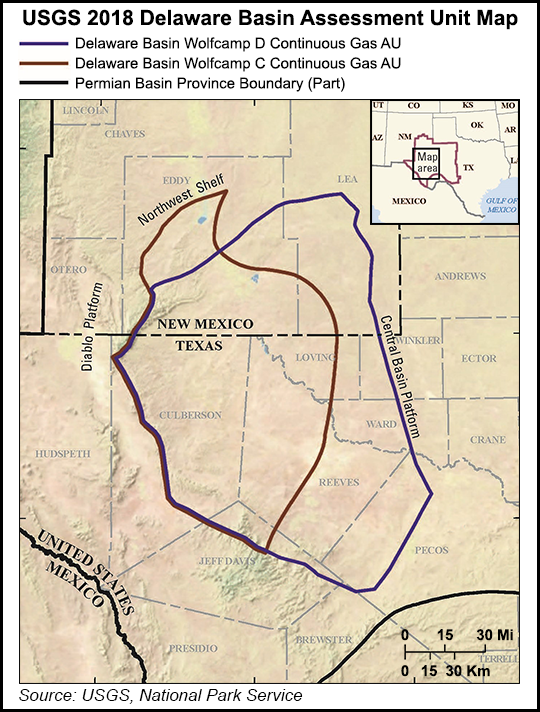Shale Daily | E&P | NGI All News Access | NGI The Weekly Gas Market Report | Permian Basin
Permian Delaware’s Wolfcamp, Bone Spring Assessed as Largest-Ever Unconventional Province
The Permian Basin’s Wolfcamp and Bone Spring formations in the Delaware sub-basin contain an estimated mean of 46.3 billion bbl of oil, 281 Tcf of natural gas and 20 billion bbl of natural gas liquids (NGL) of undiscovered, technically recoverable resources, making it the largest continuous reserves assessment ever, the U.S. Geological Survey (USGS) said.

A previous assessment was done of the Permian’s conventional resources, often produced using vertical drilling. The new assessment of the Delaware was specifically for continuous resources, i.e. formations unearthed using horizontal drilling and hydraulic fracturing, such as shale, limestone and tight resources.
“Christmas came a few weeks early this year,” Interior Secretary Ryan Zinke said. “American strength flows from American energy, and as it turns out, we have a lot of American energy. Before this assessment came down, I was bullish on oil and gas production in the United States. Now, I know for a fact that American energy dominance is within our grasp as a nation.”
Technology advancements are responsible for the over-the-top assessment, USGS Director Jim Reilly said.
“In the 1980’s, during my time in the petroleum industry, the Permian and similar mature basins were not considered viable for producing large new recoverable resources,” Reilly said. “Today, thanks to advances in technology, the Permian Basin continues to impress in terms of resource potential.
“The results of this most recent assessment and that of the Wolfcamp formation in the Midland Basin in 2016 are our largest continuous oil and gas assessments ever released. Knowing where these resources are located and how much exists is crucial to ensuring both our energy independence and energy dominance.”
The Delaware assessment of the Wolfcamp Shale and Bone Spring is more than two times larger than the USGS assessment of the Midland sub-basin in West Texas two years ago. The Midland portion of the Wolfcamp was determined to contain an estimated mean of 20 billion bbl of oil, 16 Tcf of associated natural gas and 1.6 billion bbl of NGL.
Oil and gas companies working in the Permian are producing using both traditional vertical well technology and horizontal drilling and fracturing.
The Permian province includes a series of basins and other geologic formations in West Texas and southeastern New Mexico, and today is the most productive area in the entire United States, both onshore and offshore.
“The results we’ve released…demonstrate the impact that improved technologies such as hydraulic fracturing and directional drilling have had on increasing the estimates of undiscovered, technically recoverable continuous (i.e., unconventional) resources,” said USGS’ Walter Guidroz, program coordinator of the Energy Resources Program.
Undiscovered resources are those that are estimated to exist based on geologic knowledge and already established production, while technically recoverable resources are those that may be produced using currently available technology and industry practices. Whether or not it is profitable to produce these resources is not part of the USGS evaluation.
USGS is the only provider of publicly available estimates of undiscovered technically recoverable oil and gas resources of onshore lands and offshore state waters. The Delaware Wolfcamp and Bone Spring assessment was undertaken as part of a nationwide project assessing domestic petroleum basins using standard methods and protocols.
© 2024 Natural Gas Intelligence. All rights reserved.
ISSN © 2577-9877 | ISSN © 1532-1266 | ISSN © 2158-8023 |
